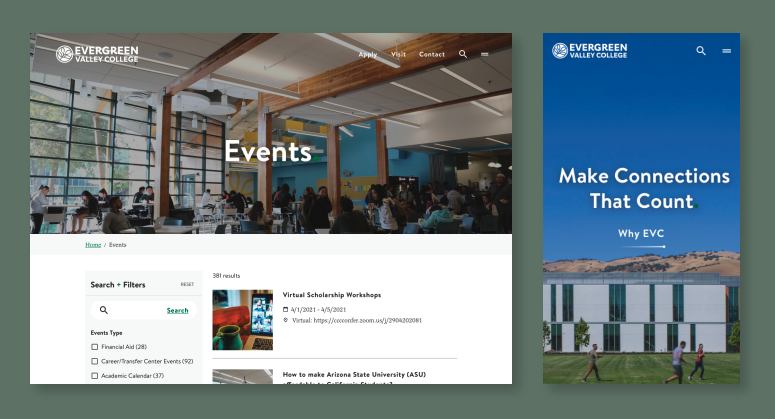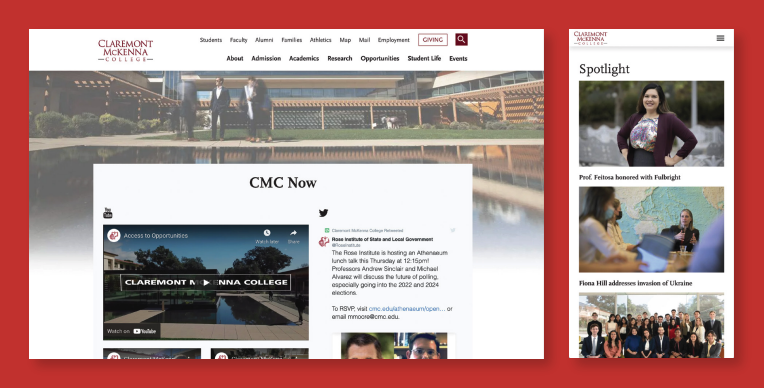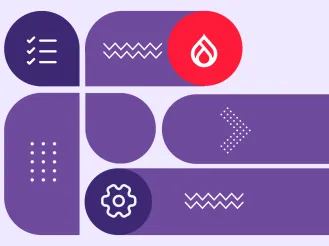The Benefits of a Composable CMS (And How Drupal Fits the Bill)
This article was updated in May 2024.
As a marketing leader, you need to drive traffic to your site and create a superior user experience. But you also need to push your content out to a variety of channels so you can reach your audience where they are.
To achieve your goals, you need a content management system (CMS) that’s flexible, scalable, and efficient. And if you’re researching your options, you’ve probably heard a lot about composable CMSs.
But what is a composable CMS exactly? How does it work — and what can it do that your current CMS cannot?
It’s more than just another web dev buzzword. We’ll help you understand what a composable CMS is and determine if this type of solution is the best option for your needs.
Exploring the Difference Between Monolithic, Headless, and Composable CMSs
If you’re researching CMS options for a website redesign or rebuild, you have three types of CMSs available: monolithic, headless, and composable.
But how does each function?
- A monolithic or traditional CMS is an all-in-one system made up of a CMS, presentation layer, and database. It’s tightly coupled, and the front-end and back-end are interconnected. That means if you make a change to one end, it automatically affects the other. A monolithic CMS is suitable for simple websites with few pages and straightforward content types.
- The opposite of a monolithic CMS is a headless, or decoupled, solution. In a headless website, the content is separate from the presentation layer and is stored in a back-end database. The front-end is built using APIs, which means the front-end and back-end can potentially live on separate servers and stem from totally different software. Even the coding languages might be different. A headless CMS is suitable for complex websites and applications that require a lot of customization. They’re typically quite expensive to build.
- The happy middle ground between these two extremes is a composable CMS. This type of CMS is built by assembling individual, loosely-coupled components that provide specific functionality. These components can include content management tools, front-end presentation frameworks, and other API-powered services.
In other words, a monolithic CMS is highly structured and inflexible; a headless CMS offers complete separation between content management and the front-end presentation; and a composable CMS provides flexibility in how the CMS is built and can be customized using a modular architecture.
While headless and composable approaches can overlap, they are not the same. A headless website is generally more complicated to build and manage, while a composable CMS is simpler and more intuitive to maintain.
How a Composable CMS Works
Composable content management systems are based on the concept of composable architecture. This software design principle emphasizes the ability to break down a system into smaller, reusable components that developers can use to create larger systems.
In the context of a CMS, a composable architecture allows you to create and manage content in a more flexible and modular way. Instead of being tied to a fixed set of features and functionality, you can:
- Choose from a range of pre-built content components and modules that can be combined and customized to meet your specific marketing needs
- Create custom content and workflows without having to rebuild your entire website from the ground up
- Display your data and services to front-end applications through an API
- Enable content to flow both ways through custom integrations that connect your website to third-party tools, platforms, services
- Be customer-centric and create data structures and models that meet your audience’s needs
Do you currently use Drupal to power your website? Good news: you already have all the capabilities of a composable CMS. Drupal is inherently composable due to its modular architecture that allows you to select and combine individual components to meet your specific needs.
However, it can be difficult to discern whether other CMSs are truly composable because some proprietary solutions like Contentful and Squarespace use similar language to describe their capabilities. They tout the ability to easily customize your website and claim to be flexible and scalable.
But in truth, these closed-source solutions can box you in. There’s a predetermined set of options to choose from, and if you want something more, you have to engage their developers to build it. That’s assuming they’re willing to do what you’re asking at all.
This means you can very quickly outgrow a closed-source, non-composable solution.

3 Reasons to Choose a Composable CMS
Let’s get down to brass tacks: Why should you invest in a composable CMS if you don’t already have one?
1. Flexibility
If your marketing plans require you to stay flexible and nimble, a composable CMS can help in the following ways:
- Create and manage content. With Drupal, it’s easy to create and manage different types of content and organize it in various formats, such as text, images, videos, and documents. And, of course, you can publish it to various channels (e.g., social media; mobile apps).
- Customize your workflows. Drupal's workflow management tools allow you to design and customize your content creation and publishing workflows. You can create different workflows for different types of content, define approval processes, assign tasks to team members, and track progress.
- Integrate with third-party tools and platforms. Drupal supports hundreds of integrations with various third-party tools and platforms — Analytics, CRMs, HR platforms, membership portals; you name it.
- Offer a multilingual experience. Using Drupal's multilingual capabilities, you can make sure your website speaks the language of all your users. Drupal supports multiple languages out of the box, and marketers can configure the platform to support additional languages as needed.
2. Scalability
If your organization is growing — or if you hope to grow over time — you need a website that will grow with you. Without an easily scalable solution, the more users, content, traffic, files, and integrations you add to your site, the worse your site performance could get. And if your site offers a slow or glitchy user experience, you may have to invest in a rebuild well before you’re otherwise ready.
Many proprietary platforms impose limits on your website’s growth. But open-source, composable solutions like Drupal don't have built-in caps. As a result, you can quickly and easily scale the content you house on your site, the number of users you support, and the volume of traffic your site can handle.
3. Extensibility
Extensibility is the ability to take an existing platform and enhance or customize its features. Proprietary CMSs vary widely in terms of extensibility — a problem you may have experienced first-hand if your team has ever had to settle for frustrating workarounds. By contrast, solutions like Drupal allow you to customize and extend your platform's functionality to meet the unique requirements of any project.

Future-Proof Your Marketing Plans With a Flexible CMS Like Drupal
The world around you is constantly evolving. And you can’t afford for your website to stay static in the face of innovation and change.
You may want to develop a simple monolithic solution today while ensuring you have a foundation you can build on in the future. Drupal can do that. Or you might want a headless site that allows you to nimbly reach your audience where they are. Drupal can handle that, too.
Whatever your marketing plans entail, you need a solution that can go the distance. A composable, flexible CMS like Drupal will give you what you need today and support you no matter what the future may hold.



